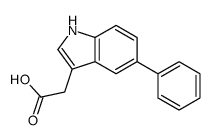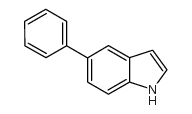168649-23-8
| Name | 2-(5-phenyl-1H-indol-3-yl)acetic acid |
|---|---|
| Synonyms | 1H-Indole-3-acetic acid,5-phenyl |
| Description | 5-Ph-IAA is a derivative of IAA. 5-Ph-IAA, a ligand, establishes the auxin-inducible degron 2 (AID2) system together with an OsTIR1 (F74G) mutant. AID2 induces rapid and efficient depletion of mAID-fused proteins to study protein function in living cells, causing tumor suppression[1]. |
|---|---|
| Related Catalog | |
| In Vitro | HCT116 cells constitutively expressing OsTIR1(F74G) are exposed to 5-Ph-IAA (1 µM; 6 hours), leading to DHC1-mAC degradation, which means the AID2 system better than the original AID system in generating conditional mutant cell lines[1]. Western Blot Analysis[1] Cell Line: HCT116 cells Concentration: 1 µM Incubation Time: 6 hours Result: Depleted DHC1-mAC efficiently in HCT116 cells constitutively expressing OsTIR1(F74G). |
| In Vivo | 5-Ph-IAA (0-10 mg/kg; intraperitoneally injection; every day; 7 days), used for the AID2 system ,is sufficient to deplete mAID-BRD4 and TOP2A-mAC, leading to tumour suppression[1]. Animal Model: Balb/c-nu female mice (7 weeks old; 16–20 g ) bearing mAID-BRD4 and TOP2A-mAC xenograft tumours cells[1] Dosage: 0 mg/kg, 1 mg/kg, 3 mg/kg and 10 mg/kg Administration: Intraperitoneally injection; every day; 7 days Result: Displayed significant tumour suppression of mAID-BRD4 xenografts and TOP2A-mAC xenografts. |
| References |
| Molecular Formula | C16H13NO2 |
|---|---|
| Molecular Weight | 251.28000 |
| Exact Mass | 251.09500 |
| PSA | 53.09000 |
| LogP | 3.46200 |



